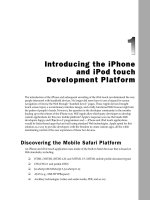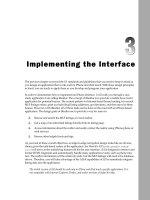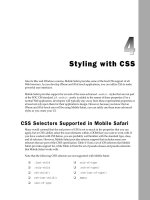Tài liệu Lập trình iphone chuyên nghiệp part 8 doc
Bạn đang xem bản rút gọn của tài liệu. Xem và tải ngay bản đầy đủ của tài liệu tại đây (577.52 KB, 13 trang )
Handling Touch Interactions
and Events
An essential part of any Web 2.0 application is the ability to respond to events triggered by the
user or by a condition that occurs on the client. The clicking of a button. The pressing of a key. The
scrolling of a window. While the user interacts with an HTML element, the entire document, or the
browser window, JavaScript serves as the watchful eye behind the scenes that monitors all of this
activity taking place and fires off events as they occur.
With its touch screen interface, iPhone is all about direct interactivity with the user. As a result,
you would expect any iPhone/iPod touch application you create to be able to handle the variety of
finger taps, flicks, swipes, and pinches that a user naturally performs as they interact with their
mobile device. However, because of the current capabilities of Mobile Safari browser, you have to
work with these interactions differently than what you might expect.
How iPhone Handles Events
When working with touch interactions and events for iPhone, keep in mind that the finger is not a
mouse. As a result, the traditional event model that Web developers are so used to working with
does not always apply in this new context. This is both good news and bad news for the applica-
tion developer. The good news is that much of the touch interaction that iPhone and iPod touch
are famous for is built right into Mobile Safari. As a result, you do not need to write any code to
handle the basic touch interactions of the user. Flick-scrolling, pinching and unpinching, and one-
finger scrolling are those sorts of user inputs that come for free. The bad news is that the developer
is greatly constrained in his or her ability to work with the full suite of JavaScript events and
override built-in behavior. As a result, certain user interactions that have become a staple to Web
developers now are impossible to utilize or require tricky, dumbed-down workarounds.
c05.indd 101c05.indd 101 12/7/07 2:47:02 PM12/7/07 2:47:02 PM
Chapter 5: Handling Touch Interactions and Events
102
The general rule of thumb for iPhone event handling is that no events trigger until the user’s finger
leaves the touch screen. The implications are significant:
❑
The
onmousedown
event handler fires only after a mouse up event occurs (but before
onmouseup
is triggered). As a result, the
onmousedown
event is rendered useless.
❑
The
onmousemove
event handler is unsupported. However, on rare occasions, our tests show
that Mobile Safari may trigger an
onmousemove
event, so developers should not assume that
these handlers will never be called.
❑
:hover
does not work.
In addition, you cannot trap for zoom events associated with the window. First, Mobile Safari provides
no built-in event handler support for zooming out or zooming in. Second, you cannot perform a work-
around by polling the window for width changes, since the width remains the same regardless of the
current zoom factor.
You cannot trap for events associated with a user switching between pages in Mobile Safari. The
onfocus
and
onblur
events of the
window
object are not triggered when the focus moves off or on a
page. Additionally, when another page becomes the active page, JavaScript events (including polling
events created with
setInterval()
) are not fired. However, the
onunload
event of the
window
object is
triggered when the user loads a new page in the current window.
Table 5-1 lists the events that are fully supported and unsupported. Table 5-2 identifies the events that
are partially supported.
Supported events Unsupported events
formfield.onblur
document.onkeydown
formfield.onchange
document.onkeypress
formfield.onclick
document.onkeyup
formfield.onfocusformfield.onkeydown
form.onsubmit
formfield.onkeyup
formfield.ondblclick
formfield.onkeypress
formfield.onmouseenter
formfield.onmouseout
formfield.onmouseleave
formfield.onmouseover
formfield.onmousemove
formfield.onmouseup
formfield.onselect
form.onreset
window.oncontextmenu
window.onload
window.onerror
window.onmousewheel
window.onresize
window.onorientationchange
window.onscroll
Table 5-1: JavaScript Event Compatibility
c05.indd 102c05.indd 102 12/7/07 2:47:02 PM12/7/07 2:47:02 PM
Chapter 5: Handling Touch Interactions and Events
103
Detecting an Orientation Change
One of the unique events that an iPhone application developer will need to be able to trap for is the
change between vertical and horizontal orientation. Newer versions of Mobile Safari (iPhone 1.1.1 and
later) provide support for the
onorientationchange
event handler of the
window
object. This event is
triggered each time the device is rotated by the user. The following code shows how to configure the
onorientationchange
event:
<!DOCTYPE html PUBLIC “-//W3C//DTD XHTML 1.0 Strict//EN”
“ /><html xmlns=” /><head>
<title>Orientation Change Example</title>
Event Level of support
document.onmousedown
Occurs after a
mouseup
event occurs but before
onmouseup
is fired
Table 5-2: Partially Supported JavaScript Events
Besides the anomaly of the timing of the
onmousedown
event, the rest of the supported mouse and key
events fire in Mobile Safari in the same sequence as a standard Web browser. Table 5-3 shows the event
sequences that occur when both a block level element and a form element are clicked. The form element
column also displays the order of key events if the user types in the on-screen keyboard.
Block-level elements (e.g., div) Form element (e.g., textarea, input)
onmouseover
onmouseover
onmousedown
onmousedown
onmouseup
onfocus
onclick
onmouseup
onmouseout
onclick
onkeydown
onkeypress
onkeyup
onchange
onblur
onmouseout
Table 5-3: Event Sequencing
(continued)
c05.indd 103c05.indd 103 12/7/07 2:47:03 PM12/7/07 2:47:03 PM
Chapter 5: Handling Touch Interactions and Events
104
<meta name=”viewport” content=”width=320; initial-scale=1.0; maximum-scale=1.0;
user-scalable=0;”>
<script type=”application/x-javascript”>
function orientationChange() {
var str = “Orientation: “;
switch(window.orientation) {
case 0:
str += “Portrait”;
break;
case -90:
str += “Landscape (right, screen turned clockwise)”;
break;
case 90:
str += “Landscape (left, screen turned counterclockwise)”;
break;
case 180:
str += “Portrait (upside-down portrait)”;
break;
}
document.getElementById(“mode”).innerHTML = str;
}
</script>
</head>
<body onload=”orientationChange();” onorientationchange=”orientationChange();”>
<h4 id=”mode”>Ras sed nibh.</h4>
<p>
Donec semper lorem ac dolor ornare interdum. Praesent condimentum. Suspendisse
lacinia interdum augue. Nunc venenatis ipsum sed ligula. Aenean vitae lacus. Sed
sit amet neque. Vestibulum ante ipsum primis in faucibus orci luctus et ultrices
posuere cubilia Curae; Duis laoreet lorem quis nulla. Curabitur enim erat, gravida
ac, posuere sed, nonummy in, tortor. Donec id orci id lectus convallis egestas.
Duis ut dui. Aliquam dignissim dictum metus.
</p>
</body>
</html>
An
onorientationchange
attribute is added to the
body
element and assigned the JavaScript function
orientationChange()
. The
orientationChange()
function evaluates the
window.orientation
property to determine the current state:
0
(Portrait),
-90
(Landscape, clockwise),
90
(Landscape
counterclockwise), or
180
(Portrait, upside down). The current state string is then output to the
document.
However, note that the
onorientationchange
event is not triggered when the document loads.
Therefore, in order to evaluate the document orientation at this time, assign the
orientationChange()
function to the
onload
event.
While the
onorientationchange
event works great for iPhone 1.1.1 and later, earlier versions of
Mobile Safari did not support this event. Therefore, if you are designing an application that works on all
versions of Mobile Safari, you need to perform a workaround to emulate this functionality.
(continued)
c05.indd 104c05.indd 104 12/7/07 2:47:03 PM12/7/07 2:47:03 PM
Chapter 5: Handling Touch Interactions and Events
105
The
window.onresize
event handler would seem like a logical candidate to trap for an orientation
change. For example, consider the following code:
<!DOCTYPE html PUBLIC “-//W3C//DTD XHTML 1.0 Strict//EN”
“ /><html xmlns=” /><head>
<head>
<title>On Resize</title>
<meta name=”viewport” content=”width=320; initial-scale=1.0; maximum-scale=1.0;
user-scalable=0;”>
<script type=”application/x-javascript”>
window.onresize = function( ) {
alert( “window.onresize detected: “+ document.body.offsetWidth +”x”+
document.body.offsetHeight );
};
</script>
</head>
<body>
<h1>Cras sed nibh.</h1>
<p>
Donec semper lorem ac dolor ornare interdum. Praesent condimentum. Suspendisse
lacinia interdum augue. Nunc venenatis ipsum sed ligula. Aenean vitae lacus. Sed
sit amet neque. Vestibulum ante ipsum primis in faucibus orci luctus et ultrices
posuere cubilia Curae; Duis laoreet lorem quis nulla. Curabitur enim erat, gravida
ac, posuere sed, nonummy in, tortor. Donec id orci id lectus convallis egestas.
Duis ut dui. Aliquam dignissim dictum metus.
</p>
</body>
</html>
In this example, a function is added as the handler for
window.onresize
, which calls an
alert()
dialog box each time a window resize is detected. While this is a logical option, the problem with using
window.onresize
to detect an orientation change is that this event is triggered inconsistently. It does
not fire off every time. In fact, it usually does not fire until after the third time the orientation changes.
As a result, until Mobile Safari corrects this issue, avoid using
onresize
.
A much better solution is to poll the browser for orientation changes using the
setInterval()
function.
Here’s a basic example:
<!DOCTYPE html PUBLIC “-//W3C//DTD XHTML 1.0 Strict//EN”
“ /><html xmlns=” /><head>
<title>Orientation Change Example #1</title>
<meta name=”viewport” content=”width=320; initial-scale=1.0; maximum-scale=1.0;
user-scalable=0;”>
<script type=”application/x-javascript”>
// add timer event
addEventListener(“load”, function() {
setTimeout(orientationChange, 0);
}, false);
var currentWidth = 0;
(continued)
c05.indd 105c05.indd 105 12/7/07 2:47:03 PM12/7/07 2:47:03 PM









